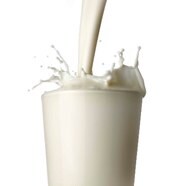Measuring Peroxidase in Milk
Visual determination after conversion of a specific substrate
Thermal treatment has a crucial effect on the quality and hygiene of food milk. The main aim of heat treatment is to kill pathogenic microorganisms or agents which cause spoilage. However, the treatment also results in changes to further milk constituents, such as, for example, deactivation of enzymes inherent in milk. The heating conditions therefore have to be set in such a way that desired properties are achieved in the end product without undesired side effects being produced at the same time.
The temperature/time ranges for the production of various types of milk are stipulated in German federal milk regulations1. Pasteurisation, ultra-heat treatment (UHT) and sterilisation are recognised heat-treatment methods. Longtime heating, short-time heating and high-temperature heating are further differentiation criteria for pasteurised milk.
For the control and characterisation of heat-treated milk, use is made, inter alia, of the temperature-dependent deactivation of enzymes inherent in milk2. Whereas the detection of alkaline phosphatase is employed for the monitoring of adequate long-time heating or short-time heating, the measurement of peroxidase inherent in milk (lactoperoxidase) enables an assessment of correct high-temperature heating. Accordingly, the activity of the original milk enzyme alkaline phosphatase must be negative and the activity of the milk enzyme lactoperoxidase must be positive in short-time heated milk, while both enzymes must be deactivated in high-temperature-heated milk.”3
The MQuant® Peroxidase test strips provide an easy and accurate way to check the presence of peroxidase in milk.
The following application note describes the determination of the peroxidase activity in milk using the MQuant® Peroxidase test strips.

Figure 1. Peroxidase in milk
Experimental conditions for peroxidase measurement in milk with MQuant® peroxidase tests
Method
Under the catalytic effect of peroxidase, an organic redox indicator is converted into a blue compound. The visual comparison of the reaction zone of the test strip with the fields of a color scale shows whether there is any peroxidase activity present (+, ++) or not (-).
Sample material
Milk
Measuring range
Yes-/No-result
The (+)-color field corresponds to peroxidase activities of >12 U/l, the (++)-color field to peroxidase activities of >100 U/l. As a rule, every blue discoloration of the reaction zone is caused by peroxidase activity.
Reagents and accessories
Reagents
Cat. No. 117828 MQuant® Peroxidase Test, colorimetric with test strips
Accessories
Block heater or water bath (23 °C) or thermometer for the measurement of the ambient temperature
Analytical approach to identify hydrogen peroxidase in milk
Sample preparation:
No sample preparation needed.
Measurement:
For analysis, follow this procedure:
Determine with the above-mentioned test kit.
- Inject 1 ml of sample (20–25 °C) with the syringe into the test vessel.
- Add 4 ml of distilled water (20–25 °C) with a pipette and mix.
- Add 5 drops of reagent POD-1 and swirl. Hold the bottle vertically while adding the reagent.
- Immerse the reaction zone of the test strip in the measurement sample for 1 sec.
- Immediately allow excess liquid to run off via the long edge of the strip onto an absorbent paper towel and after 1 min determine with which color field on the label the color of the reaction zone coincides.
- Read off the result (please refer to the package insert of the MQuant® Peroxidase Test).
- The visual comparison of the reaction zone of the test strip with the fields of the color scale shows whether there is any peroxidase activity present (+, ++) or not (-).
The color fields serve merely as a rough orientation. As a rule, every blue discoloration of the reaction zone is caused by peroxidase activity. Be aware that the color of the reaction zone may continue to change after the specified reaction time has elapsed. This must not be considered in the measurement.
Results
Comparison of the MQuant® Peroxidase Test with the reflectometric DIN method 10483-2:
The measured values were verified by performing a reference analysis with the reflectometric DIN method 10483-2. The results are shown in the following table.
ESL = extended shelf life
Conclusion
The comparison measurement showed that the results correspond with the reflectometric DIN method.
The MQuant® Peroxidase strips are a quick and easy way to check the presence of peroxidase in milk samples. With the strips it is possible to control the effectiveness of the heating procedure, which is necessary to preserve the milk and eliminate the pathogen microorganisms.
More information
- MQuant® Test Strips
- Applications
References
如要继续阅读,请登录或创建帐户。
暂无帐户?